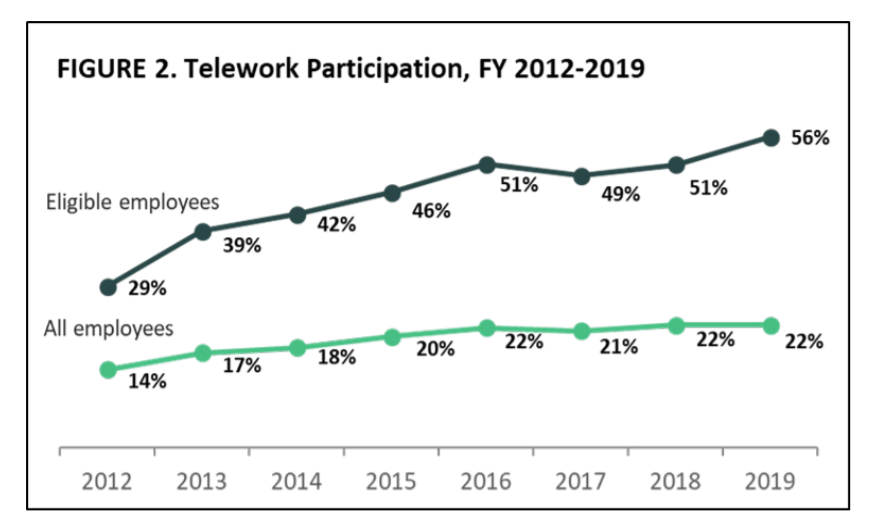A new telework snapshot from the before times
As agencies rethink their remote work policies for a post-pandemic world, new governmentwide data shows just how far agencies have come in the last two years with...
They say that hindsight is 20/20.
But when it comes to telework in the federal government, we don’t have yet a full picture of just how many federal employees shifted to remote work in 2020, the year the COVID-19 pandemic started.
We do, however, have a new picture of the before times, which illustrates just how many feds were teleworking during the year before the pandemic and how much work agencies had to do to bring their workforces to the present moment.
According to newly released data on governmentwide telework trends from the Office of Personnel Management, less than a quarter, or 22%, of all feds teleworked at some point in 2019. But among those who were actually eligible, 56% took advantage of telework that year — up 5% from the previous year.

The Defense Department alone was a major factor for the increase across government, in part because participation improved by 20% in 2019 at the Pentagon. DoD made at least 24,000 employees eligible for telework for the first time that year through continuity of operations planning efforts, according to OPM.
Clearly, this report is not indicative of what’s happening now. Maximum telework is still the lay of the land at many agencies 13 months into the pandemic.
Big cabinet agencies like the Agriculture Department are overhauling their telework policies. Other agencies are having similar conversations, and OPM is preparing new guidance to help them tread through this brand new world.
But the data is a useful point of comparison from the before times, and OPM said it plans to issue a new report with fresh data from 2020 later this year.
So what did we learn?
In the year before the pandemic, fewer feds as a share of the total workforce were eligible for telework — 39% in 2019 compared to 42% during the previous year — but OPM warns the data may be misleading.
Agencies at the time still struggled to track and report telework participation and eligibility data. Some rely on their employees to self-report when they telework, others automatically track participation through time and attendance or other systems.
Some agencies report total fiscal year telework data, and others provided only a snapshot of data from September.
Nearly half of agencies are unable to report cost savings from telework for various reasons, though some clearly had some success. The Treasury Department and the Department of Homeland Security, for example, each said they saved $4.3 million and $7.3 million, respectively, on real estate costs in 2019.
A majority, or 44%, of feds teleworked on a situational basis in 2019, a scenario that obviously changed a year later during the pandemic.
A closer look at individual agencies shows telework practices were a real mixed bag across government.
Just 44 employees teleworked at the CIA in 2019. At least 93 employees worked remotely at least once the year before.
The Defense Department did, according to the data, make some small strides on telework in 2019. About 41% of the DoD workforce was eligible, and 44% of those employees took advantage of telework at some point that year. All told, 18% of the DoD workforce teleworked, an improvement over the 15% from 2018.
At the Department of Veterans Affairs, just 9% of the workforce teleworked in 2019.
Every employee was eligible for telework at the National Science Foundation, and 94% of employees took advantage of the program at some point in 2019.
At the Social Security Administration, 44% of the workforce was eligible for telework in 2019. The agency changed its telework policies in 2019 and again in early 2020. Today, the vast majority of its employees are working from home.
A majority of employees at the Energy Department were eligible for telework back in 2019, but 60% of them took advantage of it.
Again, it’s a bit of understatement, but the state of play within most agencies is vastly different today.
Where do agencies go from here?
Some feds are already coming back to their offices with more frequency. Others are waiting it out in anticipation of new policies from their agencies and supervisors.
HR leaders across government have said things will change; telework in some form is here to stay.
Telework “eligibility” means something different now, and agencies already seem to have more data at their disposal about who’s working remotely and what they’re getting done. We’ve heard time and again how productivity at many organizations is up.
Odds are the annual telework updates will look much different moving forward, and the workplace will too.
Nearly Useless Factoid
Source: Gizmodo
Copyright © 2025 Federal News Network. All rights reserved. This website is not intended for users located within the European Economic Area.
Nicole Ogrysko is a reporter for Federal News Network focusing on the federal workforce and federal pay and benefits.
Follow @nogryskoWFED





